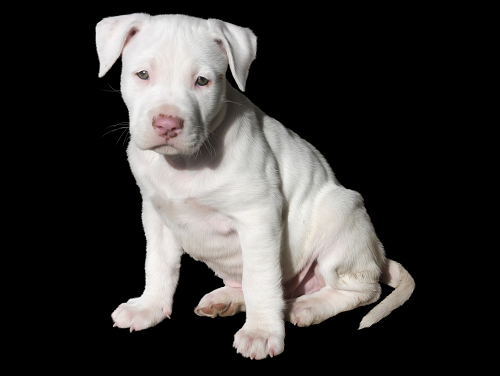Your dog could have spots, stripes and splotches on his coat, or he could have no color at all. If your dog has a winter white coat and pinkish pigment around his eyes and nose, your dog could be an albino. While this condition is rare in dogs, it is possible. This article will better familiarize you with what it means to be albino and how to care for your albino best friend.
What is Albinism?
Albinism is a disease that both plants and animals can be born with. It is characterized by an absence of pigmentation or coloration in an organism. While generally an inherited trait, it can also be caused by genetic mutation, disease, age or diet. This causes an animal to have white feathers, hair, skin or scales. Albinism also gives animals pinkish skin around the nose and sometimes the eyes. These pink eyes are due to no pigmentation being present in the iris, which allow the blood vessels to show through.
Albinism can also occur in plants. It is characterized by the lack of chlorophyll pigments which are key players in photosynthesis. Without these cells, the plant cannot use sunlight to power its everyday functions. In most cases, this condition reduces survival heavily. 
Animals get their coloration from a few different biological functions and cells that produce color on their skin, scales and feathers. Melanin is the organic pigment in people and mammals that produces the skin color. Melanin can be either eumelanin, dark browns or black, pheomelanin, reddish tans and blondes, and can work independently or together to create complex coats in some animals. Melanin is produced in melanocytes. Chromatophores are the cells which contain pigments in animals. These different pigments are responsible for the coloration in animals and can be any of the following based on the color under white light:
- Cyanophores (blue)
- Xanthophores (yellow)
- Melanophores (brown/black)
- Erythrophores (red)
Albinism is a recessive trait; meaning two animals holding the recessive gene must mate to have a baby that is an albino. Therefore, it is rare in the animal kingdom. It is also rare because the survival rate of animals with albinism is much lower and doesn’t allow them time to reproduce.
Consequences of Albinism
1. Abnormal Appearance
The most obvious effect of albinism in animals is their strange appearance. Obviously, the main symptom is the lack of pigment, characterized by white fur and pink around the eyes and nose. While their appearance does not prove to be an issue for your dog in captivity, in the wild it would be a problem. There are also cases of partial albinism in animals where certain parts of their body are lacking in color but other parts are completely normal.
2. Reduced Sun Protection
Another unfortunate trait of albinism is that the animal has a higher risk of contracting canine melanoma. The melanin in your skin protects you from the ultra-violet sun rays and without this, the frequencies enter your body unmatched. This is why animals with albinism must stay mostly indoors or underground for the duration of their lives.
3. Lower Rate of Survival
In the wild, camouflage is a huge part of an animal’s life. It uses this evolutionary trait to hunt and hide from those who hunt it. Without the correct pigments, the animals do not have their camouflage and stand out too much compared to the rest of their species. In some cases, albino animals have even been shunned from packs of animals or slighted when it comes time to find a mate because they do not have the proper markings like the rest of their group. If the animal does happen to find a mate and produce an embryo carrying albinism as well, this embryo is much less likely to be viable. This is another reason there are so few albino animals that naturally occur.
4. Loss of Vision and Hearing
Albino animals almost always have abnormal eye development caused by their albinism. Animals with albinism either have pink or red eyes due to the lack of pigment in the retina, or pale blue eyes from other color generating processes. In both cases, the retina is underdeveloped and missing the majority of the rods and cones in the retina that capture light and distinguish color. These abnormalities cause problems in the iris, retina, muscles and nerves in the eyes, leading to problems in depth perception, focus and overall quality of vision. In some rodents and other small mammals, it has been documented that albino animals may also have some hearing impairments.
How Does it Affect My Dog?
 While your dog isn’t fending for his life out in the wild, albinism can negatively affect your dog in other ways. First, albino dogs are incredibly rare, and you may not ever see a fully albino dog in person. Your dog will also have an extreme sensitivity to light and radiation. This will make your dog very susceptible to canine skin cancer and other light-related diseases. You must pay close attention to any sores or bumps on your dog, especially if he is out in the sun often.
While your dog isn’t fending for his life out in the wild, albinism can negatively affect your dog in other ways. First, albino dogs are incredibly rare, and you may not ever see a fully albino dog in person. Your dog will also have an extreme sensitivity to light and radiation. This will make your dog very susceptible to canine skin cancer and other light-related diseases. You must pay close attention to any sores or bumps on your dog, especially if he is out in the sun often.
This light sensitivity is not the only issue your dog may have. Your albino dog will also have eye issues caused by his disease. The underdeveloped lenses and retinas in your dog’s eyes make his vision poor and blurry or even in some cases, renders him completely blind. Your dog will have small and deformed eyes, and these are all incurable and unfixable due to the fact they are directly connected to albinism. He should also wear doggy goggles when outside to not damage his eyesight even further.
In some cases, your dog may also have some hearing issues associated with his albinism. In certain dogs, it causes complete canine deafness. There are still studies being done to find the exact connection between deafness and albinism.
Extra Care
Due to their myriad of health concerns, if you do bring home a dog with albinism, you will have to be sensitive to his issues. The first most important measure of protection is to keep him out of the sun. If you cannot keep your dog from running around in the sunshine, you will have to take other precautions. Some websites even suggest keeping your dog’s coat as long as possible to protect him from the sun. There are sunscreens, gadgets and gear most albino dogs wear to protect them from the UV rays. Goggles should be purchased to protect his incredibly sensitive eyes from the sun. Without these, his eyes will burn, and he may even develop cancer in them as well. You must be sure to use these as your dog’s best chance of protecting himself from the very real risk of skin cancer.
Overall, your albino dog may look differently from others, but his other characteristics such as personality and energy will be completely normal. If you’re willing to do some extra work, your next best friend could be a little white-haired, albino pup.
Sources:
“10 Facts You Should Know About Albino Dogs.” Puppy Toob, 2 July 2018, puppytoob.com/albino-dogs/.
“Albinism.” Wikipedia, Wikimedia Foundation, 24 June 2019, en.wikipedia.org/wiki/Albinism.
petMD. “PetMD.” PetMD, 9 Feb. 2018, www.petmd.com/dog/general-health/albino-dogs-interesting-facts-you-should-know.
“What Is an Albino Dog? | Hill’s Pet.” Hill’s Pet Nutrition, www.hillspet.com/dog-care/behavior-appearance/albino-dogs.




